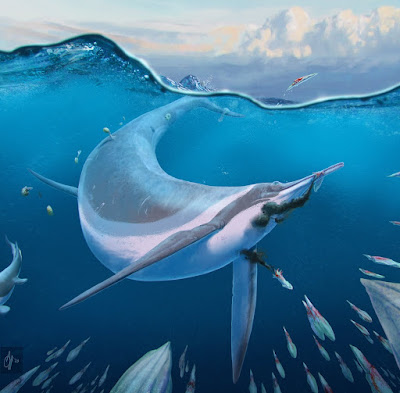Abstract
Besanosaurus leptorhynchus Dal Sasso & Pinna, 1996 was originally described on the basis of a single complete fossil specimen excavated near Besano (Italy). However, a recent taxonomic revision and re-examination of the cranial osteology allowed for the assignment of five additional specimens to the taxon. Here, we analyse, describe and discuss the postcranial anatomy of Besanosaurus leptorhynchus in detail. The size of the specimens examined herein ranged from slightly more than one meter to eight meters. Overall, several diagnostic character states for this taxon are proposed, demonstrating a mosaic of plesiomorphic and derived features. This is best exemplified by the limbs, which show very rounded elements in the forelimbs, and pedal phalanges with retained rudimentary shafts. We suggest that the widely spaced phalanges in the forefins of Besanosaurus leptorhynchus were embedded in a fibrocartilage-rich connective tissue, like in modern cetaceans. We also review the similarities of Besanosaurus with Pessopteryx and Pessosaurus, allowing us to conclude that Besanosaurus is not a junior synonym of either of the two taxa. Lastly, to test the swimming capabilities of Besanosaurus leptorhynchus, we expanded on a previously published study focussing on reconstructing the swimming styles of ichthyosaurs. Besanosaurus leptorhynchus was found to possess a peculiar locomotory mode, somewhat intermediate between anguilliform swimmers, such as Cymbospondylus and Utatsusaurus, and some shastasaur-grade (e.g., Guizhouichthyosaurus) and early-diverging euichthyosaurian (e.g., Californosaurus) ichthyosaurs. Based on our results, we furthermore suggest that mixosaurids acquired their characteristic body profile (dorsal fin and forefins that are distinctly enlarged compared to the hindfins) independently and convergently to the one that later appeared in Parvipelvia. Moreover, the different swimming styles inferred for Cymbospondylus, Mixosauridae, and Besanosaurus strengthen the earlier hypothesis of niche partitioning among these three distinct ichthyosaur taxa from the Besano Formation.
Keywords: Ichthyosauria, Shastasauridae, Middle Triassic, Besano Formation, Monte San Giorgio, Postcranial anatomy, Osteology, Phylogeny, Swimming style, Marine reptiles
Gabriele Bindellini, Andrzej S. Wolniewicz, Feiko Miedema, Cristiano Dal Sasso and Torsten M. Scheyer. 2024. Postcranial Anatomy of Besanosaurus leptorhynchus (Reptilia: Ichthyosauria) from the Middle Triassic Besano Formation of Monte San Giorgio (Italy/Switzerland), with Implications for Reconstructing the Swimming Styles of Triassic Ichthyosaurs. Swiss Journal of Palaeontology. 143: 32. DOI: doi.org/10.1186/s13358-024-00330-9

